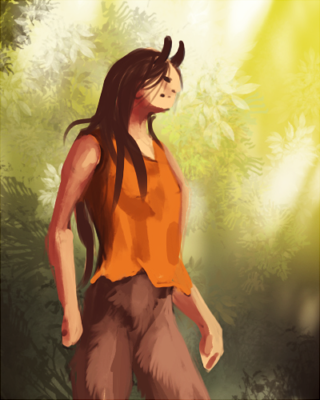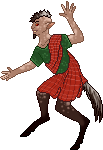The Faun

General Information;
Light-hearted, goat-legged humanoids with a deep connection to music. Staunch devotees of Balion, they have a close bond with the earth element. They are friendly to all facets of nature, and may often be found in the company of elves or Evylonian deer.
Statistics;
Name:: Faun
Average Lifespan:: 200 years
Average Height:: 5ft/1.5m
Average Weight:: 130 pounds
Location Found:: Abroad, though have focused in Evylon.
*all statistics based on averages; extremes in any direction, or found in odd locations, are always allowed.
Notes;
Diet This is what this species, and any variants, may eat at any given time.
Common:
fruit, nuts, mushrooms, grain, cheese.
Uncommon:
tubers, fish, succulents, white meat.
Rare:
red meat.
Overview:
Fauns are omnivorous, but prefer to sate their hunger with whatever they can gather while traveling, most often in the form of local fruits and berries, mushrooms, or nuts, while they often trade for hardy breads and cheeses when they pass through settlements. They only rarely eat meat of any sort, with red meat being most rare.
Satyrs have much the same diet as fauns, though they only rarely trade for food, preferring to live off the land. Meat is more common a part of their diet than it is for fauns, though they share the same tendency to go for white meat or fish over red meat.
Credits;
Species info credited to Verridith, Fyfergrund, Icarusa, and Soundthebugle.
In-Depth Information;
Appearance Fauns are often seen as short humanoids, lithe and athletic. From the waist down, they have the legs of a bovidae or similar ungulate, while the rest of their bodies look largely indistinguishable from a human or an elf, aside from the horns on their heads. Males have longer horns, usually seven or eight inches in length, sometimes straight, sometimes curled, while females' horns are shorter, usually three to four inches, and more delicate looking. Males also tend to sport short beards growing from their chins.
Fur and hair color varies widely, from natural browns, blacks, and creams to bold colors much like a bird's plumage. Skin color likewise varies, as do markings. A faun may choose to have decorations carved into their horns and hooves, often in swirling patterns - those that choose a warrior's path may cover their horns in plates of spiked metal. Jewelry, often of natural materials, is common. Usual apparel is a short, sleeveless tunic with a simple belt fastened around their waist, often of muted earth tones; most do not don pants, though some may wear loose, short leggings. They often wear their hair in a variety of styles, though loose and unbound is most often seen.
While goats are most common, bovine- and cervine-like fauns are uncommonly found. Called by a variety of (usually derogatory) names, these fauns may sport minotaur-like, jutting horns or branching antlers and are considered lesser by their brethren. Both of these types may be larger than their normal kin, and are considered dumb and brutish, even if they are every bit as refined and intelligent as goat-faun.
Culture As a race, fauns are welcoming and kind, easy-going, and very loyal. Optimistic and energetic, they stubbornly persevere regardless of whatever adversity they face. Many families will raise their children collectively, creating strong communities. Lone fauns are very rare, but are commonly young males who have left their families to find significant others of their own, outside of the group.
A nomadic race, they travel in bands of a handful to several dozen, living off the land, and whatever they may be able to barter for. Since they lack much by way of wealth, their usual offer is their music. As a race, there are no finer musicians in all the realms, for a faun with an instrument is capable of weaving spells through music, whether it be instrument or song. All fauns, regardless of other tasks - such as guards or warriors - know how to play any sort of instrument, and often are taught how to make and maintain their tools lifelong.
Abilities A faun's greatest and most well-known ability is that of music. Music, instrumental or through vocal singing, can be used to control elemental earth and mesmerize listeners, allowing the fauns to beguile their foes and escape unharmed. The more fauns involved, the stronger the magic they can conjure. Less common is the ability to cast magic without music; such abilities are typically less potent.
Often known as the small spirits of the forest, fauns are able to 'sing' a plant or many plants to grow in what way they want - be it in some shape, simply faster growth, or a variety of other ways. They can restore a devastated forest in a matter of days, inspiring new growth over dead trees, charred earth, and tainted land. With their music, they can also sing away disease in any flora, and bring it from the brink of death to full and blooming health. It's said that their gift comes from a unique twist on the resonance of kv'naer, not real words, but using an echo of its influence.
Aside from their music, they are fast runners, and skilled marksmen with bows. Should they be forced to, they wield club-like weapons such as maces, flails, stout clubs, and morning stars with more zeal than skill, but their light-footed athleticism means this is usually enough. They have sharp eyesight and hearing, and can nimble weave through a forest at full speed.
Species Origin;

When the halflings began to establish permanent settlements in Evylon, a fair many of them decided they weren’t keen on giving up their nomadic ways. Generally traveling in small clans, these halflings began to undergo a different mutation than their settled fellows, affected largely by the magic of the Realm.
As they wandered, they noticed their feet beginning to harden, and change shape, while their legs lengthened and short horns began to sprout from their heads. In a few generations, they had ceased to be halflings, and became fauns. Just as agile as the halflings, if not moreso, the fauns were far faster. They also gained a deep connection to the earth, learning how to call upon its aid through music.
While the halflings were by and large content to remain on Evylon, many fauns left their Realm of origin, and took to wandering through the other Realms as they pleased. However, most choose to return to Evylon sooner or later, almost instinctively drawn back to the forests from which they originated.
This species did not have an Ancient First.
subspecies

Satyr
Classification: mischievous, horse-tailed fauns. Location: Evylon.
Similar in many ways to their faun cousins, satyrs are well known for their mischievous ways. They are infamous tricksters and greatly enjoy playing pranks and jokes on others, usually harmless ploys for their own amusement. Satyrs tend to be carefree and light-hearted individuals who tend towards general revelry, making them the life of any party. Quite a few are musically gifted, especially with string and woodwind instruments, and can use their songs to aid in their tricks. Being tricksters comes at a price and other races may view them warily, assuming they’re always up to something. A reputation for clever mischief precedes them, but most are welcomed across the realms anyway, for the merriment and joy they bring in their wake.
Their tails are long and horse-like, as opposed to the short goat-tails of fauns, and most tend to be highly nomadic. They are more likely to wander abroad, driven by wanderlust and curiosity. Inquisitive natures tend to make them restless and satyrs desire to see as much of the realms as possible. Well-traveled satyrs earn great prestige among other fauns and the highest traveled are respected members of their species.
